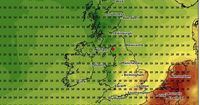After a summer that saw the United Kingdom grappling with relentless heat, four official heatwaves, and weather records tumbling, September 2025 has arrived with a fresh set of surprises. As the calendar flipped to meteorological autumn, many Britons expected the return of cool breezes and grey skies. Yet, the nation finds itself in a tug-of-war between lingering summer heat and autumn’s traditional chill, with forecasters and residents alike watching the skies for the next twist in this year’s weather saga.
According to the Met Office, summer 2025 was "almost certainly" the UK's warmest ever, boasting an average temperature of 16.13°C up to August 28. This figure surpasses the previous record of 15.76°C set in 2018, knocking the legendary summer of 1976 out of the top five. In fact, all five of the UK's warmest summers have now occurred since the year 2000—a statistic that leaves little doubt about the changing climate. Emily Carlisle, a Met Office scientist, noted, "This would move 1976 out of the top five warmest summers since 1884, leaving all five warmest summers having occurred since the year 2000." (The Independent)
Yet, as September dawned, the weather shifted gears. Early in the month, much of the UK was greeted by scattered showers, drizzle, and temperatures dipping into the high teens Celsius. But just as quickly, forecasters began to spot signs of another warm spell. By Monday, September 1, central and southern England were basking in temperatures above 30°C—enough to meet the Met Office's official heatwave criteria, which require threshold temperatures to be exceeded for three consecutive days. This sudden return of heat prompted the UK Health Security Agency to issue Yellow and Amber Heat Health Alerts for England, warning that vulnerable groups could face increased risks. Night-time temperatures in the southeast refused to dip below 20°C, creating the rare phenomenon known as a tropical night (IBTimes).
For those living in Norfolk and Suffolk, the balmy conditions lingered. On Wednesday, September 3, these counties were set to reach 25°C, with other regions like Cambridgeshire and Lincolnshire expected to climb as high as 26°C by Tuesday, September 9. Counties including Bedfordshire, Berkshire, Buckinghamshire, Greater London, Hertfordshire, Kent, Leicestershire, Lincolnshire, Northamptonshire, Nottinghamshire, Rutland, Surrey, and parts of Yorkshire also enjoyed temperatures between 21°C and 25°C (Daily Star, Express).
But this taste of summer wasn’t universal. While the southeast sizzled, Wales, Northern Ireland, and Scotland braced for a chillier climate. The Met Office forecasted a “mixed bag” for the start and middle of September, with sunny spells in some places and heavy rain or even thunderstorms in others. Low pressure systems began to dominate, bringing showers, longer spells of rain, and the possibility of hail and strong winds—especially in the west and north. The unsettled weather was set to move eastwards by Tuesday, September 2, causing travel disruptions in Scotland and the northern regions (Express).
Despite the dramatic swings, meteorologist Craig Snell of the Met Office cautioned against getting too excited about a sustained heatwave. Speaking to The Independent, he said, "Our general trend, as we go through to the second week of September, is that, on the whole, for the UK, it is probably going to remain on the changeable, unsettled side of the weather. It looks like there will be some drier and brighter spells at times... It will be early September, so in any sunnier moments, it will still feel fairly warm out there." He added that while an early autumn heatwave couldn’t be ruled out, the more likely scenario was a continuation of warm yet unsettled conditions.
Indeed, the Met Office’s long-range forecast for September 6 to September 15 predicted that changeable weather would continue, with low pressure systems dominating. Showers, heavy rain, thunderstorms, and even hail were all on the cards, with the heaviest downpours expected in the west. For the second half of the month, from September 16 to September 30, forecasters anticipated more of the same: low pressure, showers, and some longer spells of rain, but also the possibility of drier, more settled interludes—especially at the start of the period. Temperatures were expected to hover around average, perhaps turning warmer than average later in the month (Daily Star, Express).
With the mercury rising again, talk inevitably turned to the prospect of an "Indian summer"—that fabled spell of warm weather in early autumn. However, experts were quick to pour cold water on the idea. As IBTimes explained, the current warm spell doesn’t meet the traditional definition of an Indian summer, which usually refers to a period of warmth after the first frost, often in October or November. While September 2023 delivered the UK’s longest September heatwave on record—seven consecutive days above 30°C, peaking at 33.5°C in Faversham, Kent—the hottest September day ever remains 35.6°C, recorded back in 1906 in Bawtry, South Yorkshire. This year’s warm spell, though notable, is not expected to rival those records.
Still, the current warmth is not without its challenges. The UK Health Security Agency’s heat alerts have urged health and social care providers to prepare for a spike in heat-related cases, particularly among older adults, infants, and those with existing medical conditions. Residents have been advised to stay hydrated, avoid strenuous activity during the hottest parts of the day, and take care during warm, humid nights that could disrupt sleep and increase heat stress—especially in urban areas (IBTimes).
Looking further ahead, the Met Office suggests that as September progresses, low pressure will continue to influence the weather, bringing a mix of sunshine, showers, and the occasional thunderstorm. Some drier, settled spells are possible, particularly at the start and end of the period, but the general outlook is for changeable conditions. October, on the other hand, is likely to bring a return to the more familiar bleak and wet autumn weather, with the prospect of heavy rain, strong winds, and a noticeable drop in temperatures.
The summer of 2025 will be remembered not just for its record-breaking heat, but for the way it has blurred the lines between the seasons. As the UK transitions into autumn, the weather remains as unpredictable as ever—one day delivering a blast of summer, the next a taste of the coming chill. For now, Britons are advised to keep both their umbrellas and sunglasses close at hand, as the nation rides out the rollercoaster of weather that has defined this extraordinary year.


